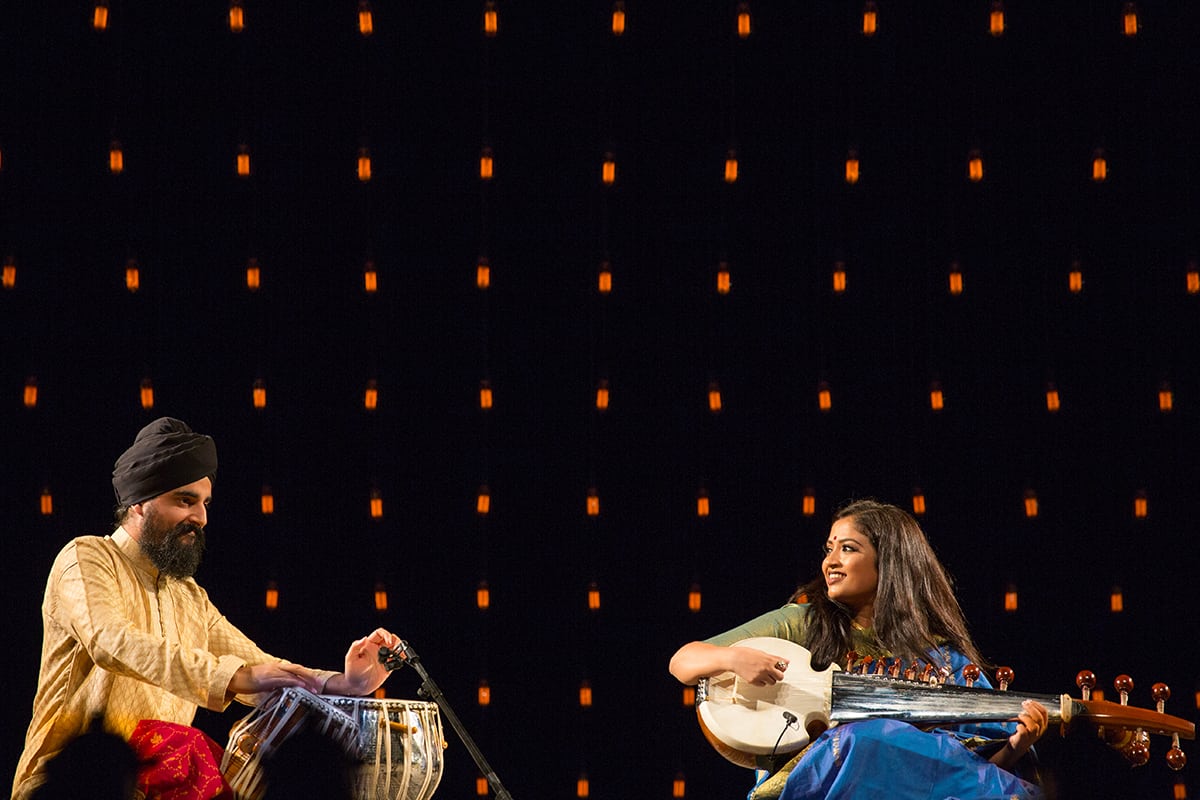This year the Darbar Festival came to the Sadler’s Wells’ stage for the very first time since its inception in 2006. This concert showcased the talents of Debasmita Bhattacharya and Gurdain Rayatt. Debasmita began her musical journey at the age of 6 under the guidance of her father, the renowned sarod maestro Debashish Bhattacharya. Today she is a highly-accomplished player in her own right and has received many accolades, including first prize in the 2008 Sangeet Praveen Competition, and she achieved a top position in the 2013 Dover Lane Music Competition and the Rajya Sangeet Academy Competition. In July 2015, Debasmita was one of 100 musicians selected to participate in Ethno Sweden.
Accompaniment was provided by Gurdain Rayatt, undoubtedly one of the UK’s finest tabla-players of his generation. He began playing at the age of 3 under the tutelage of his father Harkirat Rayatt and his grandfather Bhai Gurmit Singh Virdee, who specialises in both the Punjab and Benares gharanas (stylistic schools). He went on to receive his professional training from the late Pandit Shankar Ghosh and his renowned son Bikram. A year-long stint in Kolkata allowed Gurdain to undergo rigorous training. Inspired by the great performers of our time and due to his father’s efforts in the promotion of tabla, he has received further guidance from many of the greats including Pandit Suresh Talwalkar, Pandit Yogesh Samsi, Pandit Subhankar Banerjee, Pandit Nayan Ghosh and Satyajit Talwalkar. This rich and varied lineage from the Benares, Farukhabad and Punjab gharanas has contributed to his broad repertoire and creativity in performance. To date, he has performed globally with leading classical Indian musicians including Pandit Birju Maharaj, Srimati Saswati Sen, Pandit Debashish Bhattacharya, Ustad Nishat Khan, Ustad Amjad Ali Khan and Soumik Datta. He has also partaken in cross-cultural collaborations including with ‘Kefaya’, ‘Michael Messer’s Mitra’, Bernhard Schimpelsberger and Jesse Bannister.
The stage, backlit with rows of yellow lights, created an atmospheric setting as the evening stole into the alap (introductory section) of Jhinjhoti, a night-time raga. The essence of the raga was introduced with a beautifully and melodically-improvised alap, in which basic elements were explored and developed without rhythmic punctuation. Although Jhinjhoti is known to be a light and playful raga, it is by no means devoid of depth. The sarod is known for its naturally deep, weighty, introspective sound, with sympathetic strings that give it a resonant, reverberant quality. The Persian word roughly translates as ‘beautiful sound’ or ‘melody’, and Debasmita brings to it a serenity and emotive lucidity in addition to technical virtuosity: a perfect combination of ingredients for bringing across the rasa (flavour) of this raga, Sringara (love and romance). As the piece progressed to the jor (following the alap and jhala (climax)), we had the opportunity to hear the force that is Gurdain Rayatt. His teental theka (pattern of the 16-beat cycle), playful yet subdued at first, moved from vilambit (slow) to drut (fast) laya (speed) for the jhala, as the rhythmic element gathered momentum and overtook the melodic. Soaring towards the sam (denouement), we got a taste of his prowess on the tabla: energetic, powerful, explosive.
Each raga is designated for a particular time of day, and it is generally considered inappropriate for it to be performed outside of this window. An exception to the rule seems to be raga Mishra Bhairavi, a late-morning raga. Owing to the popularity of this raga, its window was extended to early morning. It then became customary to bring down the curtain on a Hindustani mehfil (an evening of music in an intimate setting) with this raga, providing it concluded after midnight. This slowly stretched even further to incorporate concerts that did not stretch into the early hours, and was the raga of choice to be performed as a dhun (a light instrumental piece). As the short alap unfolded, the audience witnessed Debasmita’s sarod capturing the pensive, reflective tone of the raga. Coupled with her purity of tone and the bending and sustaining of notes on this fretless instrument, she was able to produce brilliantly the effect of meend (glissandi), producing a deeply calming effect. The tabla crept in, providing the pulse in six beats (dadra), as Gurdain played with the rhythmic cycle with delightful intricacy and inventiveness. A little-known but interesting fact is that Debasmita’s father’s guru, Buddhadev Dasgupta and Gurdain Rayatt’s guru, Pandit Shankar Ghosh used to perform together, which makes this an exciting real-life example of the younger generation taking the baton in perpetuating this beautiful art form. A truly unique performance from two of Indian classical music’s rising stars ended befittingly with riotous applause and a standing ovation.
